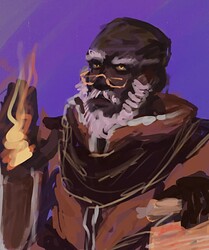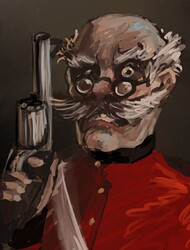Thanks to @HanonO mentioning it on several topics I have posted, I have begun playing Fallen London about a month ago. I can confidently say I have been thoroughly enjoying it, and the Quality Based Narrative underpinnings solve several design problems I have struggled with. However, I realised it might be a fun challenge to build a browser based narrative game like it, put out a very barebones version initially, and then nourish it into a bigger game over time. Developing in Unity has felt very much like a grind until the product is done, whereas this might trick my brain into nourishing the game regularily.
To this end, I have some design pillars I wanted to set, and I would really appreciate some extra eyes on this.
1. Split mechanical outcome decisions from narrative outcome decisions
Ergo, if you complete a section of story, and you are prompted to make the final decision, split the decision into a decision about reward, and a decision about narrative direction. I find it very tempting, for me at least, to pick choices which I have available to me because of a high skill or stat to get a bigger payout for example.
I want to make sure that the narrative direction the story takes is a conscious narrative decision, not one informed by ‘potential future rewards’, unless those rewards are adressed in a narrative way. In other words, you may pick the option that has you betray a friend for a large payout, so long as the game then allows you to pick a roleplay option saying something like “I betrayed him for the money, but I regret doing so. I needed the money”.
2. Have a mechanical representation for characterisation, but lock these behind big character moments
I like how Fallen London has qualities such as Subtle, Hedonist and Austere. I also like how these can alter your decision space. What I did not like is the fact they later turned into a resource, rather than a representation of my character. So, I would very much like to include something like thus, but allow them to only be modified at set points in the story.
3. Recognise when the player does something frequently
A big part of being a citizen of the Neath is apparently doing crime. I have robbed so many houses to get the resources I need, and I can’t quite mesh that with the headcanon of my character. It might be nice for repeated activities to build a quality such as ‘Seen at the Factory’ or ‘Frequents University’, which then in turn allows you to tell the game why you keep doing this. Whether it’s out of desperation, enjoyment, or a true pillar of identity.
In this way, you could almost curate a game experience to offer more opportunities for characterisation to the player by feeding into their chosen identity. Kind of like a social media feed, really.
4. Prevent Skyrim syndrome
Fallen London has you explore every facet of its weird and wacky world, and come out as a paragon of that facet of Neath society. You find yourself raising all your core attributes to the maximum, turning you into the epitome of all of them. It works for Fallen London, but I don’t like that from a roleplaying perspective.
Instead, I intend to give players a ‘level’, and then attribute modifiers attached to that. These are also chosen at major points in the story, or consciously sought out. So, a character might be level 28, with a +8 modifier to intelligence from qualities such as ‘keen-minded’ and ‘scholarly’, but a -2 on Strength (example names) because they picked ‘frail’ near the start of the game.
Then, use level and modifiers to neatly scale the skill checks in some way without causing cognitive dissonance about the nature of your character.
Of course, include a method later in the game to change these decisions if the player regrets them, but lock that behind something big.
Little side note: for these qualities I was thinking of instead describing the activity, like Martial, Scholar, Subterfuge, Artisan, etc.
5. Announce the importance of a decision
When a decision is presented to the player, make sure the player is aware of the impact they make with the decision. Not the exact impact, just how much they need to make sure what they choose here and how much it affects their future experience. This puts more narrative agency in the player’s hands.
6. Make big item ‘grinds’ little events in and of themselves
This is a minor decign decision, but I really liked how Heists and other Carousel activities lock you out from the outside world for help. You need to prepare for an activity, and once you have done so, you commit to it. This allows me, as the designer, to introduce some tension into the activity. There is some greater leeway for me to throw curveballs at the player in these instances.
7. Have important decisions you made recur, or even haunt you
There is one story in Fallen London I love. The one about the Comtessa and the Clay Men. What this story does excellently is provide you an ambigious choice, and then throughout much of the early game occasionally reminds you of the choice you made. The choice has no mechanical benefit at all, but you keep being confronted with it. I want more story decisions to recur like this, if only in little acknowledgements. This is excellent feedback to attempts at roleplay.
That was it. What do you think? To end with, here are two sketches I made to try and find an aesthetic to work with.




